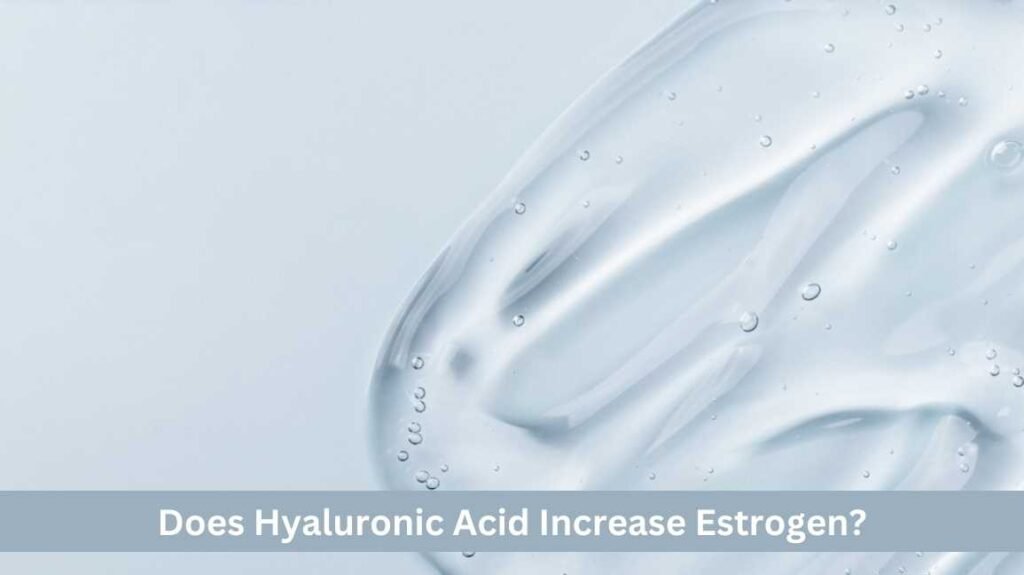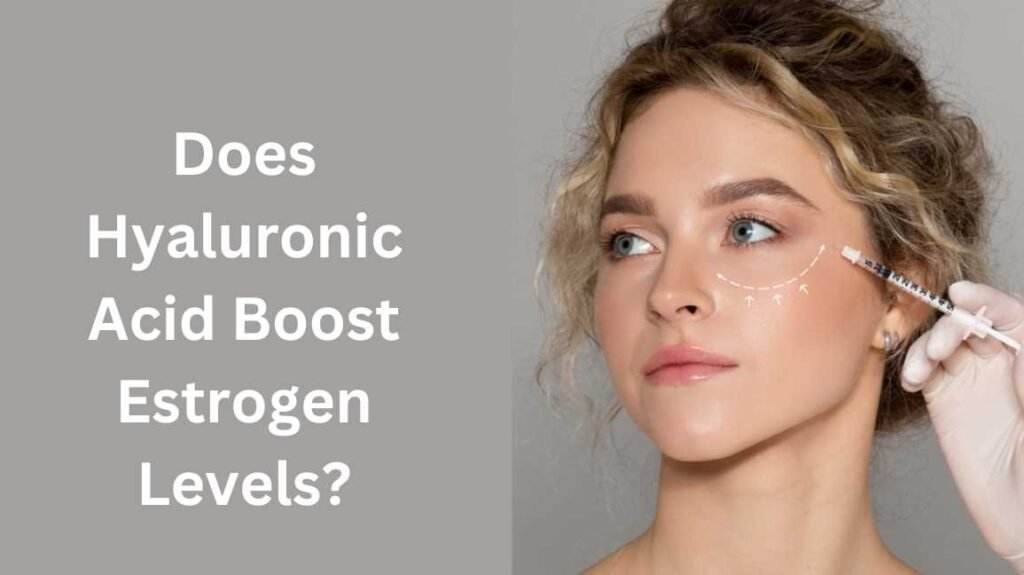Does Hyaluronic Acid Increase Estrogen?

Hyaluronic acid (HA) is a naturally occurring substance in the body that helps keep skin hydrated and lubricated. It is also found in other tissues such as cartilage and the eyeballs.
HA has gained popularity in recent years for its use in skincare products and cosmetic procedures, such as dermal fillers.
One question that often comes up when discussing HA is whether it can increase estrogen levels in the body. This topic is of interest to many individuals, particularly women who are concerned about hormonal balance and the potential side effects of using HA-based products.
In this article, we will explore the relationship between HA and estrogen and provide some insight into whether or not HA can affect estrogen levels.
What is Hyaluronic Acid?
Before delving into the potential effects of Hyaluronic acid on estrogen levels, it’s important to understand what exactly hyaluronic acid is and how it works in the body.
HA is a type of glycosaminoglycan (GAG), which is a long chain of sugars that are found naturally in the body. It plays an important role in maintaining the structure and function of connective tissues, including skin, cartilage, and joints.
One of the main functions of HA is its ability to attract and retain water molecules, which helps keep tissues hydrated and lubricated. This makes it an essential component for healthy skin and joints.
HA has been used for various medical and cosmetic purposes, including:
- Treatment for dry eyes
- Lubrication of joints in individuals with osteoarthritis
- Wound healing and tissue repair
- Dermal fillers for wrinkles and facial volume loss.
Now that we have a better understanding of HA, let’s discuss estrogen and its role in the body.
What is Estrogen?
Estrogen is a hormone that plays a crucial role in the development and regulation of various bodily functions. It is mainly produced in the ovaries in females and in smaller amounts in the testes and adrenal glands in males.
Some of the functions of estrogen include:
- Regulating the menstrual cycle and reproductive system
- Maintaining bone density
- Supporting cardiovascular health
- Affecting mood and cognitive function
- Regulating skin health and appearance.
Estrogen levels naturally fluctuate throughout the menstrual cycle, with the highest levels occurring during ovulation. It also decreases during menopause, which can lead to various symptoms such as hot flashes and changes in skin and hair.
Does Hyaluronic Acid Boost Estrogen Levels?

Now, let’s address the question at hand: Can HA increase estrogen levels in the body?
The short answer is no. There is currently no evidence to suggest that HA can directly stimulate the production or release of estrogen in the body.
However, there are some potential indirect ways that HA may affect estrogen levels:
1. Skin Health: The skin is the largest organ in the body and plays a vital role in hormone metabolism. By keeping the skin hydrated and healthy, HA may indirectly support hormonal balance.
2. Collagen Production: Collagen is another key component of skin health and can be affected by estrogen levels. As mentioned earlier, HA has been shown to stimulate collagen production, which may indirectly impact hormone levels.
3. Inflammation Control: Estrogen has anti-inflammatory effects in the body. Since HA also has anti-inflammatory properties, it may help reduce inflammation and support estrogen’s role in regulating bodily functions.
Scientific Research on the Topic
There isn’t direct evidence that hyaluronic acid itself increases estrogen levels. Hyaluronic acid works differently than estrogen. Here’s what the research suggests:
- Hyaluronic Acid for Vaginal Concerns: Studies compare hyaluronic acid to estrogen for treating vaginal dryness post-menopause. Both show effectiveness, but estrogen might be slightly better for dryness, while hyaluronic acid excels with itching. This suggests they address different aspects.
- Hyaluronic Acid as an Estrogen Carrier: Research exists on using hyaluronic acid to deliver estrogen (estradiol) specifically to brain tissue. This design aims for a more targeted approach with potentially lower overall estrogen dosage.
However, clinical trials are necessary to validate its effectiveness and ensure its safety.
Factors Influencing Estrogen Production
Several factors can influence estrogen production in the body. These include:
Age: Estrogen levels typically decrease with age, especially during menopause.
Body Fat: Fatty tissue can produce estrogen; hence, body fat percentage influences overall estrogen levels.
Diet: Certain foods can impact hormone levels. For example, soy products contain phytoestrogens, which can mimic estrogen.
Exercise: Regular physical activity can help regulate hormone levels and promote a healthy balance.
Stress Levels: Chronic stress can affect hormone balance, including estrogen levels.
Genetics: Genetic factors can play a significant role in how much estrogen a person produces.
Medications: Hormonal medications, like birth control pills or hormone replacement therapy, directly affect estrogen levels.
Health Conditions: Conditions such as polycystic ovary syndrome (PCOS) or ovarian insufficiency can alter estrogen production.
Understanding these factors can provide insights into maintaining hormonal balance and addressing issues related to estrogen levels.
Benefits and Risks of Increased Estrogen Levels
While there are potential benefits to having balanced estrogen levels, too much or too little can have adverse effects on health. Some possible benefits and risks of increased estrogen levels include:
Benefits:
- Improved skin health and appearance
- Reduced risk of osteoporosis
- Better mood and cognitive function
- Regular menstrual cycle.
Risks:
- Increased risk of breast cancer
- Irregular menstrual cycles or fertility issues
- Mood swings and irritability
- Increased risk of blood clots.
It’s essential to speak with a healthcare provider before making any changes that may affect your estrogen levels.
Common Myths and Misconceptions
There are numerous myths and misconceptions surrounding both HA and estrogen. Here are some of the most common ones debunked:
Myth: Hyaluronic acid is only beneficial for external use on the skin. While HA does have many benefits for skin health, it can also be taken orally or injected for other purposes, such as joint lubrication.
Misconception: Estrogen causes weight gain. While hormonal changes can contribute to weight gain in some individuals, there isn’t a direct link between estrogen levels and weight gain.
Misconception: Men don’t produce estrogen. While men do have significantly lower levels of estrogen compared to women, it still plays a crucial role in their reproductive and overall health.
Conclusion
In summary, hyaluronic acid does not directly increase estrogen levels in the body. However, it may indirectly support hormonal balance through its effects on skin health, collagen production, and inflammation control.
Various other factors can influence estrogen production in the body, and maintaining balanced levels is crucial for overall health. It’s essential to consult with a healthcare provider before making any changes that could affect estrogen levels and to debunk myths and misconceptions about HA and estrogen.
FAQs
Does estrogen increase hyaluronic acid?
Yes, estrogen can increase the production of hyaluronic acid in the body. Estrogen has been found to stimulate the production of hyaluronic acid in skin cells, particularly in the dermis.
This is one reason why estrogen levels can positively affect skin health, leading to improved hydration, elasticity, and overall appearance.
Can I use hyaluronic acid as a replacement for estrogen therapy?
No, hyaluronic acid should not be used as a replacement for estrogen therapy. While hyaluronic acid offers various benefits for skin health and joint lubrication, it does not have the hormonal properties required to replace estrogen therapy.
Are there any side effects of using hyaluronic acid?
Yes, there can be side effects of using hyaluronic acid. While hyaluronic acid is generally considered safe and well-tolerated, some individuals may experience side effects, especially if it is injected.
Common side effects can include redness, pain, and swelling at the injection site. More serious but rare side effects may include infections or allergic reactions. When used topically, side effects are minimal, but it could cause mild irritation or allergic reactions in sensitive skin types.
What are some alternatives to hyaluronic acid for hydration?
Some alternatives to hyaluronic acid for hydration include:
Glycerin: A popular humectant that attracts moisture to the skin, helping to maintain hydration levels.
Aloe Vera: Known for its soothing and hydrating properties, aloe vera is often used in skincare to provide moisture and calm irritation.
Ceramides: These are lipids that help to form the skin’s barrier and retain moisture, making them effective for hydration and protection.
Useful Resources
WebMD- Hyaluronic Acid
MedicalNewsToday- Everything you need to know about estrogen


